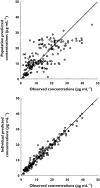Population pharmacokinetic analysis of vancomycin in neonates. A new proposal of initial dosage guideline
- PMID: 21039765
- PMCID: PMC2997311
- DOI: 10.1111/j.1365-2125.2010.03736.x
Population pharmacokinetic analysis of vancomycin in neonates. A new proposal of initial dosage guideline
Abstract
Aim: To determine the population pharmacokinetic parameters of vancomycin in neonatal patients with a wide range of gestational age and birth weight, and subsequently to design an initial dosing schedule for vancomycin in neonates.
Methods: Using nonlinear mixed-effects modelling (NONMEM VI), the pharmacokinetics of vancomycin were investigated in 70 neonates with postmenstrual age and body weight ranging 25.1-48.1 weeks and 0.7-3.7kg, respectively. A one-compartment linear disposition model with zero order input and first-order elimination was used to describe the data. Nine demographic characteristics and 21 co-administered drugs were evaluated as covariates of clearance (CL) and distribution volume (V(d) ) of vancomycin.
Results: Weight-normalized clearance of vancomycin was influenced by postmenstrual age (PMA) and co-administration of amoxicillin-clavulanic acid. Weight-normalized volume of distribution was influenced by co-administration of spironolactone. CL and V(d) of the typical individual in this study population (PMA = 34.6 weeks, weight = 1.7kg) were estimated to be 0.066lh(-1) kg(-1) (95% CI 0.059, 0.073lh(-1) kg(-1) ) and 0.572lkg(-1) (95% CI 0.505, 0.639lkg(-1) ), respectively. This model was used to predict a priori serum vancomycin concentrations in a validation group (n= 41), which were compared with observed concentrations to determine the predictive performance of the model. The 95% confidence interval of mean prediction error included zero for both peak and trough vancomycin concentrations.
Conclusions: Postmenstrual age, co-administration of amoxicillin-clavulanic acid and spironolactone have a significant effect on the weight-normalized CL and V(d) . An initial dosage guideline for vancomycin is proposed for preterm and full-term neonates, whereas the population pharmacokinetic model can be used for dosage individualization of vancomycin.
© 2010 The Authors. British Journal of Clinical Pharmacology © 2010 The British Pharmacological Society.
Figures



Similar articles
-
Population pharmacokinetics of vancomycin and AUC-guided dosing in Chinese neonates and young infants.Eur J Clin Pharmacol. 2018 Jul;74(7):921-930. doi: 10.1007/s00228-018-2454-0. Epub 2018 Mar 30. Eur J Clin Pharmacol. 2018. PMID: 29602981
-
Vancomycin pharmacokinetics in preterm neonates and the prediction of adult clearance.Br J Clin Pharmacol. 2007 Jan;63(1):75-84. doi: 10.1111/j.1365-2125.2006.02725.x. Epub 2006 Jul 21. Br J Clin Pharmacol. 2007. PMID: 16869817 Free PMC article.
-
Population pharmacokinetics of vancomycin in premature Malaysian neonates: identification of predictors for dosing determination.Antimicrob Agents Chemother. 2010 Jun;54(6):2626-32. doi: 10.1128/AAC.01370-09. Epub 2010 Apr 12. Antimicrob Agents Chemother. 2010. PMID: 20385872 Free PMC article.
-
A Review of Vancomycin, Gentamicin, and Amikacin Population Pharmacokinetic Models in Neonates and Infants.Clin Pharmacokinet. 2025 Jan;64(1):1-25. doi: 10.1007/s40262-024-01459-z. Epub 2025 Jan 16. Clin Pharmacokinet. 2025. PMID: 39821208 Free PMC article. Review.
-
Vancomycin: pharmacokinetics and administration regimens in neonates.Clin Pharmacokinet. 2004;43(7):417-40. doi: 10.2165/00003088-200443070-00001. Clin Pharmacokinet. 2004. PMID: 15139793 Review.
Cited by
-
Population pharmacokinetics of vancomycin and AUC-guided dosing in Chinese neonates and young infants.Eur J Clin Pharmacol. 2018 Jul;74(7):921-930. doi: 10.1007/s00228-018-2454-0. Epub 2018 Mar 30. Eur J Clin Pharmacol. 2018. PMID: 29602981
-
Population Pharmacokinetics Modeling of Vancomycin Among Chinese Infants With Normal and Augmented Renal Function.Front Pediatr. 2021 Sep 20;9:713588. doi: 10.3389/fped.2021.713588. eCollection 2021. Front Pediatr. 2021. PMID: 34616698 Free PMC article.
-
External evaluation of neonatal vancomycin population pharmacokinetic models: Moving from first-order equations to Bayesian-guided therapeutic monitoring.Pharmacotherapy. 2024 Dec;44(12):907-919. doi: 10.1002/phar.4623. Epub 2024 Nov 15. Pharmacotherapy. 2024. PMID: 39544156 Free PMC article.
-
External Evaluation of Population Pharmacokinetic Models of Vancomycin in Large Cohorts of Intensive Care Unit Patients.Antimicrob Agents Chemother. 2019 Apr 25;63(5):e02543-18. doi: 10.1128/AAC.02543-18. Print 2019 May. Antimicrob Agents Chemother. 2019. PMID: 30833424 Free PMC article.
-
The interplay between drugs and the kidney in premature neonates.Pediatr Nephrol. 2014 Nov;29(11):2083-91. doi: 10.1007/s00467-013-2651-0. Epub 2013 Nov 12. Pediatr Nephrol. 2014. PMID: 24217783 Review.
References
-
- Matzke GR. Vancomycin. In: Evans WE, Schentag JJ, Jusko WJ, editors. Applied Pharmacokinetics: Principles of Therapeutic Drug Monitoring. 3. Vancouver: Applied Therapeutics. Inc.; 1992. pp. 1–35. 15.
-
- Asbury WH, Darsey EH, Rose WB, Murphy JE, Buffington DE, Capers CC. Vancomycin pharmacokinetics in neonates and infants: a retrospective evaluation. Ann Pharmacother. 1993;27:490–6. - PubMed
-
- De Hoog M, Mouton JW, Van den Anker JN. Vancomycin. Pharmacokinetics and administration regimens in neonates. Clin Pharmacokinet. 2004;43:417–39. - PubMed
-
- De Hoog M, Schoemaker RC, Mouton JW, Van den Anker JN. Vancomycin population pharmacokinetics. Clin Pharmacol Ther. 2000;67:360–7. - PubMed
-
- Seay RE, Brundage RC, Jensen PD, Schilling CG, Edgren BE. Population pharmacokinetics of vancomycin in neonates. Clin Pharmacol Ther. 1994;56:169–75. - PubMed
MeSH terms
Substances
LinkOut - more resources
Full Text Sources
Medical

